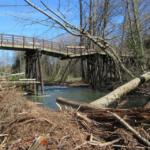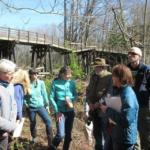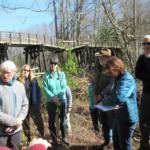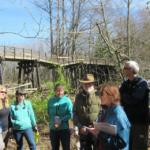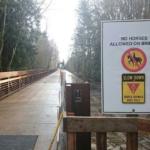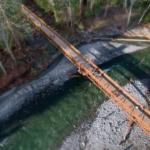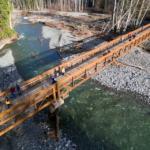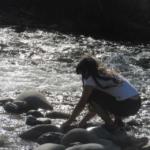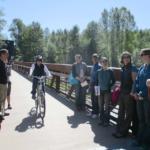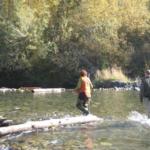A Winter storm in November of 2014 caused flooding and record high water flows on the Dungeness River that scoured a new channel beneath the west trestle of the 100 year old Railroad Bridge at Dungeness Audubon Center. A subsequent storm in February of 2014 tore away bridge pilings and significantly changed the river’s course in a westward direction. The bridge, a key portion of the Olympic Discovery Trail; was closed for repairs, cutting off the approximately 120,000 annual bridge crossings by pedestrians, cyclists and runners.
Also in that area of the Dungeness River are Chinook and Puget Sound Steelhead which are listed under the Endangered Species Act, along with pink and coho salmon. The river and salmon have lost much of their needed floodplains area according to the Dungeness Chapter of the Puget Sounds Chinook Recovery Plan.
Fortunately, replacement of the westward trestle was a component of the Lower Dungeness Floodplain restoration projects on the North Olympic Lead Entity’s four year workplan as previously proposed by the Jamestown S’Klallam Tribe. Any proposed projects must be on the workplan to gain funding through our grant round. Projects can only be added to the workplan once a year and that open enrollment period had already ended.
The bridge’s west trestle was part of the workplan because it was not a salmon-friendly structure. The 570 foot trestle bisected the river’s floodplain and was held up by a significant number of creosoted pilings, which negatively impacted the river, water quality and the ability for wood to pass beneath the bridge.
The project also benefited from the fact that the damage happened right as the Washington Legislature headed into session to figure out the state’s budget for the next two years, with the new Puget Sound Acquisition & Restoration funding becoming available only five months later. This is critically important since much of the funding allocated by the Lead Entity is available only once every two years.
In addition, there were leftover funding from the Floodplains by Design Program as well as returned funds which the Lead Entity and the Washington Recreation & Conservation Office allocated to the Tribe to begin design of a new bridge trestle which would solve the issues that made the previous trestle The Salmon Recovery Funding Board approved the project early in order to help expedite the project. The project was funded, planned, designed, permitted and construction completed in then months, by December of 2015 which is virtually unheard of for the size and scope of a bridge trestle replacement and restoration of this size.


